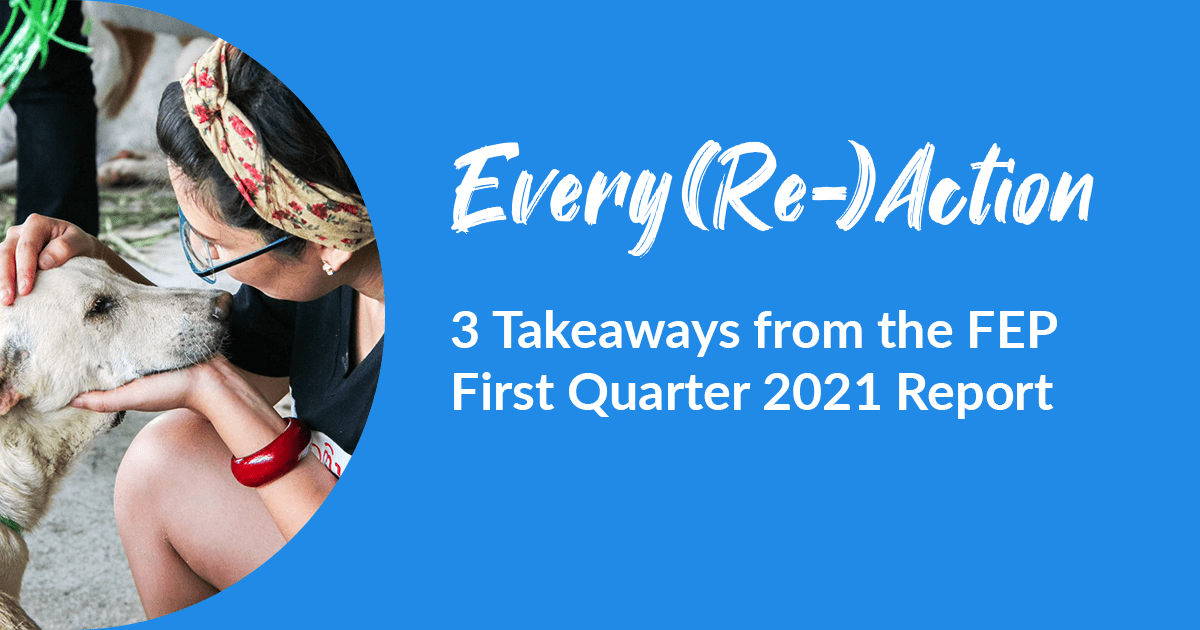Every(Re)Action: 3 Takeaways from the FEP First Quarter Report

Three promising trends are emerging from the Fundraising Effectiveness Project’s (FEP) 2021 First Quarter Fundraising Report, which was released today. The report projects a 10% growth in donors, overall retention is up 1% as compared to the prior year, and results varied widely between different sizes and types of organizations.
The Fundraising Effectiveness Project (FEP) is a collaboration among fundraising data providers, researchers, analysts, associations, and consultants to empower the sector to track and evaluate trends in giving. The FEP releases quarterly findings on those giving trends, released both via downloadable reports and in a free online dashboard.
Donors Are Up!
The first quarter of 2021 saw the largest increase in donors that has been reported by the FEP. The number of new donors from 2020 that gave again in 2021 was up 35 percent, as compared to the first quarter of 2020. Fundraisers know that new donors and new retained donors have been declining for years, so it’s encouraging to see these numbers moving in the opposite direction.
The growth we saw in the new retained donors was driven in part by an increase in recurring donations. While the data doesn’t tell us for sure which specific Q1 donations were recurring, we do know that nearly 50 percent of the new retained donors had 2 or more gifts within the first three months of the year. This is promising and may suggest that recurring donations—also known as sustaining gifts—could be one antidote to fundraising’s retention problem.
Retention is Up!
It’s encouraging to see a small increase in overall retention for Q1. Retention has experienced a long downward slide over the last 15 years—it fell to 44 percent in 2020, down from 50 percent in 2005—and that history is what makes Q1’s 1 percent increase noteworthy. There was large growth in 2020, which typically would yield a lower retention rate. (Fundraisers often see this trend when looking at disaster donors, and 2020 gave us all more than enough disasters to confront.) That overall retention increase of 1 percent tells us we might not see a big retraction in 2021, but it’s still too early to tell.
This increase in retention was spread across new and repeat donors. The new retained retention rate led the way, with a 13.6 percent improvement. The repeat retained donor retention rate increased by 2.5 percent growth, as compared to the prior year. We’ll be interested to see if this trend continues through the second quarter of 2021.
More Context on Quarterly Metrics
All wins are worth celebrating, but let’s drill down and get some important context for the FEP quarterly metrics. These numbers represent averages, and that only tells half the story. The median growth for last year’s panel of organizations actually decreased in dollars. This means more than half of the organizations lost donors and donations in 2020, even though there were more of both across the board.
Human Services organizations represented 32 percent of the dollars raised in 2021 and saw growth of 11 percent. The only other cause areas that experienced growth in Q1 2021 were the Environment and Animals. In comparison, there were declines for organizations doing work in International and Foreign Affairs (-21 percent) and Education (-18 percent.) These findings reinforce something we know about 2020 giving: many organizations who saw spikes in giving were directly influenced by a very busy news cycle, and not all organizations received the same level of attention from donors.
Our Take
The first step every organization should take is to measure their performance—what gets measured gets moved. The FEP offers a Fundraising Fitness Test for organizations to evaluate themselves, and EveryAction clients have these metrics available to them in their dashboards.
The second step organizations should take is to identify areas where you did differently than the sector averages and develop hypotheses as to why. Did you have to cancel a big event because of the COVID-19 pandemic? Were you experiencing the large growth others saw when providing frontline responses to COVID or social justice issues? Did you stop fundraising altogether?
After you assess where you are and why, the third step is to start building a plan to either reverse course or maintain. If, for example, your nonprofit saw many new donors, what is your plan to retain them? Make sure you have a robust strategy to convert as many of your new donors as possible into sustainers—including the use of predictive models to target those most likely to convert. On the other hand, if your organization suffered revenue losses in 2020, it’s time to develop a plan to recoup your losses and build out your campaigns using multiple channels so that you aren’t too reliant on too few revenue sources.
Of course, as we’re looking back on Q1, we’re already experiencing all the changes of Q2! In many parts of the United States, in-person events are beginning to reopen and travel is becoming more possible, all of which will affect nonprofit fundraising plans. If we’ve learned anything from 2020, it’s the importance of agility—getting good at adapting your plans to changing circumstances means you can keep advancing your mission, no matter your situation.


